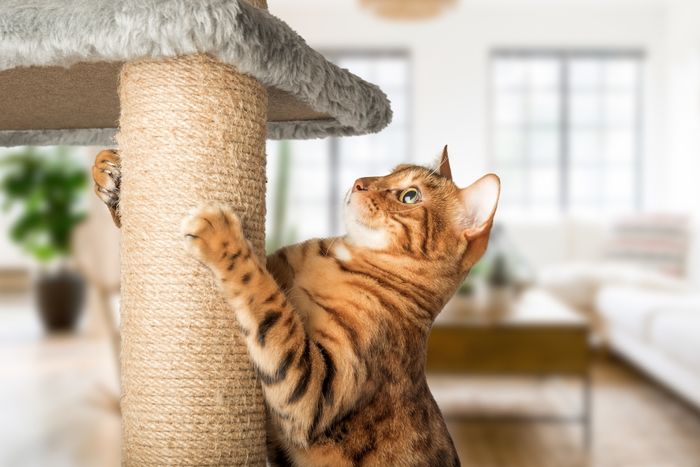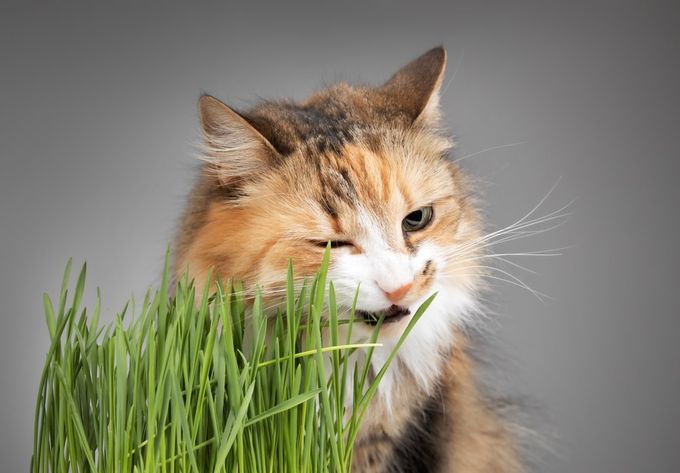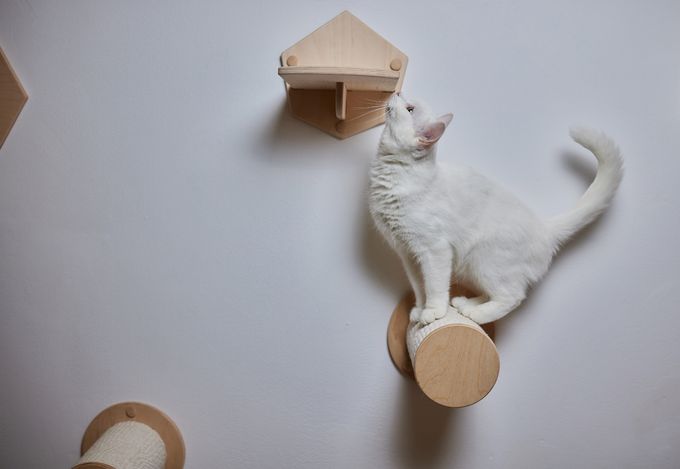Purr-Fectly Content: Creating an Enriched Home for Your Indoor Cat
Updated July 27, 2023.

Environmental enrichment for cats involves creating an optimal space that allows them to engage in activities essential for their well-being and happiness. This includes natural behaviors like hunting, playing, socializing, climbing, and scratching.
If your cat cannot exhibit its natural behaviors, it may experience separation-related problems, like stress, anxiety, and even depression, leading to behavioral problems. So, the key is to find ways to facilitate these natural behaviors in your home in a conducive way.
To shed some light on indoor cat enrichment, we spoke to an expert cat behaviorist, veterinary nurse, and founder of Wild Cats Feline Behaviour, Francesca Lees.
5 Social Enrichment Options for Cats
There are a few indoor cat enrichment ideas you can try to help entertain your cat while at work. The first step is to set up and implement strategies before you leave the house. Some of these are:
1. No-Bowl Feeding System
This system contains a pack of small, plastic mice that you distribute daily food portions into and hide around the house. "This encourages your cat's natural hunting instincts as they have to find the mice and play with them until the food falls out," says Lees.
Hybrid breeds with higher hunting instincts, such as Bengals and Savannahs, can benefit as the mice stimulate their natural feeding behavior.
2. Automated Toys
You may be asking "How do I stimulate my cat?" Luckily, some companies offer toys that activate at different times each day thanks to built-in timers. These can help boost your cat's activity. Some design examples include:
- A little bird on a ball that randomly starts spinning during the day
- A toy that houses a mouse inside a block of cheese that pops up at various times
3. Camera-Based Treat Dispensers
You can control these dispensers via an app on your phone. This allows you to check on your cat, communicate through the camera, and dispense a treat at the press of a button.
4. Bird Boxes
Bird boxes can be an exciting distraction for your cat. You can attach a clear box filled with bird seeds to a window. This allows your cat to watch birds as they feed, which can be appealing for indoor cats.
5. Optimize Environment
At the end of the day, no one wants to jeopardize their cat's safety for the sake of enrichment. It's about bridging the two. Here are some ways to stimulate your indoor cat with some outdoor time depending on your home spaces:
- Gardens: A cat containment fence system involves attaching a barrier to the top of your existing fence, creating an enclosure that prevents your cat from climbing out. Some companies install it for you or you can do it with mesh and brackets. "Look up 'DIY cat fence' on YouTube or Google for tutorials," suggests Lees.
- Flats/Apartments: Mesh covers for windows or balconies allow your cat to enjoy fresh air without the risk of escaping.
- No Access to Outdoor Grass: You can get cat grass, usually available in trays with seeds. You simply sow the seeds, water them, and the grass grows. Many cats enjoy eating grass, and this allows them to have that experience indoors.
Tip: If you don't have garden access, you can include cat-friendly indoor plants, like catnip and lavender, as they have a calming effect. But be sure to keep an eye on your cat as ingestion of lavender plants can cause upset stomachs.
How to Mentally Stimulate Your Cat
Engaging in mentally stimulating cat enrichment strategies is crucial. Here are some ways you can put this into practice:
Puzzle Feeders
Using puzzle feeders challenges your cats' thinking. They must strategize to retrieve the food. For example, there's a tower-like feeder which requires you to fill it with food and treats, twist it, and leave it. The cat then has to figure out how to retrieve the treats, usually by using its paw.
Vertical Spaces for Cats
Cats monitor their surroundings from elevated positions like trees or walls, giving them a sense of control and safety since they can anticipate any surprises. It's a natural behavior, so discouraging cats from climbing on countertops or window sills could lead to stress.
Enclosed Outdoor Space or Cat Patio
A cat patio ('catio') is a great space to boost enrichment. Some people construct an enclosure at the back of their house and connect it with a cat flap. This space is typically filled with climbing areas, toys, food hung from trees, and even large pieces of old trees for added stimuli. "These sanctuaries allow cats, particularly wild cat hybrids, to exhibit more natural behaviors without risking free-roaming," explains Lees.
Additionally, allowing areas for your cat to observe the outdoors, like through a window, can be mentally stimulating.
Active Play
You can play games where you pull a toy along, prompting them to stalk, pounce, and capture it. Research shows that indoor-only cats have a more intense and enthusiastic response to toys that resemble prey than cats who have exposure to the outdoors regularly. So, it's important to stay vigilant and not yell or punish your cat if it becomes a bit rowdy.
Do Cats Like Baby Talk?
Cats are more responsive to "baby talk" coming from their owners and can perceive humans' moods based on this.
Activities Cat Owners Should Avoid
Laser Pens
Cats have a natural instinct to stalk, pounce on, and catch their prey, providing them with a sense of achievement. However, with a laser pen, they can stalk and pounce, but they can never catch the laser dot. "The continuous chasing and failure to catch the target can cause overstimulation and severe frustration," says Lees.
Fingers, Hands, and Toes
Teaching them to chase and attack these body parts can lead to unwelcome behavior, such as biting your hands or toes while you're watching TV because they've learned to perceive these as targets. Additionally, wiggling your hands under bed covers can equate your movements with targets, and your cat could attack while you sleep.
"If you don't want your fingers and toes to be considered toys or prey by your cat, don't use them for play, especially when dealing with kittens," says Lees. "They will grow up thinking it's normal."
Games on Screens
They might tap the screen and "catch" the virtual mouse, making it stop. However, it's unclear if this gives them the same sense of accomplishment as catching something physically.
But if your cat seems to enjoy a digital game, it's okay to let them play if you monitor their behavior. Should they show signs of frustration, it's best to turn off the game.
Certain Object Play
Avoid using objects for play that you wouldn't want your cat to associate with playtime in the future. For instance, if you let them play with shoelaces, they might develop a habit of chasing them every time they see any.
» Curious about some of your cat's behavior? Learn if cats wiggle their butts before pouncing
DIY Cat Enrichment Toys
There are many creative ways you can include enrichment toys and engagement in your cat's day-to-day life.
- Puzzle feeders: These can be made from simple materials like toilet roll tubes or other cardboard tubes. Just attach them to a piece of paper and drop treats into the tubes.
- Plastic bottle on a string: Turn the bottle upside down, place large treats inside, and make a hole in the lid just big enough for the treats to fall through. Then, hang the bottle on a string. When your cat bats at the bottle, it will spin and the treats will drop out.
- Levels: You can purchase inexpensive shelves to give your cat more room to climb and create a feeling of more space. Many stores, like IKEA, sell picture shelves that are wall mountable in a stair-like configuration. Make sure you add some carpeting for added grip.
"One of my clients, who had two cats that weren't getting along very well, built a series of shelves at the top of their staircase. It was a great success—one of the cats spent most of his time up there, reducing stress and helping both cats feel more comfortable in their shared space," says Lees.
» Find out if pet insurance is worth getting for your indoor cat
Content and at Ease
Providing a variety of games and activities is a great way to enrich your cat's life. But it's just as important to pay attention to how your cat responds to different toys or spaces you implement in your home so you can adjust where needed if your cat is not feeling fulfilled. And whenever uncertain about your cat's behavior, it's best to seek professional help. At the end of the day, your cat will appreciate the engagement, your encouragement of their natural instincts in a productive way, and the mental stimulation.



